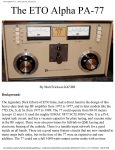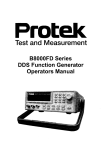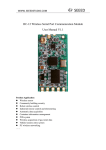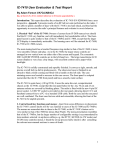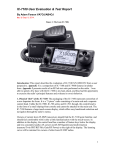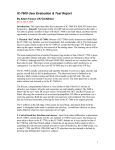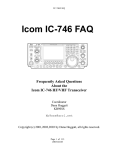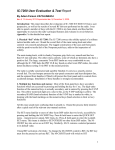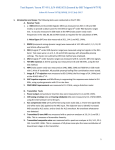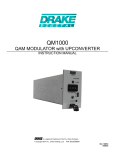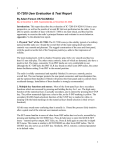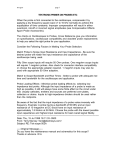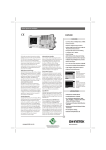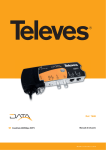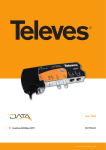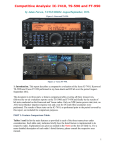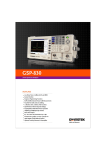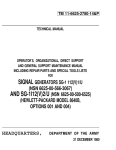Download A brief review of the ICOM IC-7700
Transcript
A brief review of the ICOM IC-7700 A brief review of the IC-7700. By Matt Erickson, KK5DR (Images courtesy of ICOM Inc.) 7800 jr? file:///C|/Users/Matt%20Erickson/Documents/My%20Rigs/7700/7700.htm (1 of 7) [5/26/2008 10:28:08 AM] A brief review of the ICOM IC-7700 I was present at Dayton 2007 where ICOM introduced the IC-7700. I was also given the chance to actually handle the prototype display unit (Thanks, Ray!). Few attendees were allowed such an honor. Now, nearly a year later the model is ready for sales. One can think of the 7700 as half of a 7800, at about half the price, but with all of the receiver performance and then some. It has only one receiver, and a PA with 200W output. It also has a built-in PSU and ATU. It inherited many of the best designs from its older brother. If you have always admired the 7800, and wished you could afford one, the 7700 is your golden chance to do just that. I feel that most ham operators do not need the sub-receiver features of the 7800, but really desire its receiver performance. The 7700 delivers that performance at a price that is easier to swallow. Where does the 7700 sit on the ICOM radio food chain relative to price? It is a step down from the 7800, but a step up from the 756ProIII. Is it "second" in line as far as performance goes? That is what I plan to find out. The FCC granted the IC-7700 certification on Feb. 11, 2008. I saw photos of the test setup, and the unit under testing was S/N 0001. ICOM always starts its production serial numbers at 1000, so this unit under test was an early prototype, and would not likely ever be seen by a buyer anywhere. The first production units arrived at the US dealers in late March 2008; the entire first production run was sold out by mid-April 2008. It is unknown outside of ICOM how many units were in this first run. Much can be learned from the sales brochure and the user manual. If you take the time to read these documents, I'll not re-state the obvious things that can be found there. This will let me get on with examining the 7700 feature by feature. I will do some direct "side-by-side" comparisons of the 7700 with my faithful 7800, which should prove very interesting. For a more technical overview of the IC-7700, stop in on my friend Adam's web page. I have little faith in lab tests which I have found prove little in the way of "actual" on-air performance. Thus, I will perform a few tests that I call "real world" tests which get results using actual on-air signals as much as possible. These tests are a little subjective, but I think reflect a more realistic performance benchmark. These tests can also be reproduced by the average ham who has a few pieces of test gear or can get them easily. file:///C|/Users/Matt%20Erickson/Documents/My%20Rigs/7700/7700.htm (2 of 7) [5/26/2008 10:28:08 AM] A brief review of the ICOM IC-7700 Rear panel: The photo above shows the rear panel of the 7700. It is much like the 7800 minus the sub RX connections. Switching PSU air exhaust port and switches are on the right. The PA vents are center above the 4 antenna ports, and the ATU cooling fan exhaust is on the left side. BNC connectors are for RX antennas and transverter. To the right are a set of SP/DIF in and out optical digital ports for routing audio in or out. Comparing dimensions: 7700 dimensions, 425mm wide by 149mm tall by 437mm deep. Weighs 22.5kg . very small. 7800 dimensions, 424mm wide by 149mm tall by 435mm deep. Weighs 25kg. We can see that the difference is Other differences: A few of the other differences between the 7800 and the 7700 are: A front-panel USB port for the keyboard, and a flash memory stick. The 7800 has a USB port for the keyboard on the rear panel, and a CF card port on the front. Many of the controls on the front panel of the 7800 are duplicates for the sub-RX. The 7700, having only a single RX does not have these dual controls; the most striking omission is the "B" VFO knob. The 7700 has later-generation DSP IC's, which have a higher processing speed than the 7800 DSP. The 7700 uses a pair of MRF-150 MOSFET transistors in the transmitter. The 7800 uses a pair of SD-2931 MOSFET transistors. My 7700: file:///C|/Users/Matt%20Erickson/Documents/My%20Rigs/7700/7700.htm (3 of 7) [5/26/2008 10:28:08 AM] A brief review of the ICOM IC-7700 Serial number; 1003 Firmware version 1.02 The photos cannot capture the true beauty of this radio. The main tuning knob alone is a piece of art, and a joy to hams who still love the feel of a smooth, well balanced tuning knob. The end of this knob has a deep clear plastic inlay which shines like a jewel. The smaller outer ring knob controls have a small rubber ring on each for extra grip, just like the main knob. The fit and finish is smooth, and sleek black, a thing of beauty. The unit arrives with rack-mount handles installed. Since I prefer the free-standing type of installation, I took them off and stored them. There are extensions for the front feet included with the unit, but I did not install mine because my unit is at eye level on my bench. I thought that I was impressed with the appearance of the 7800, but the 7700 has me even more impressed and proud to have such a beautiful radio in my shack. I tested all features and functions on my 7700, and they all work as they should. For a very early version, it is a good sign. Visible difference: The first thing I notice when I powered up my 7700 for the first time, is the scope "grass" level; it is half that of my 7800. There is no denying it, with both radios on, and not connected to an antenna, I can see the difference. Next, I notice the resolution bandwidth (RBW) is a little narrower than that of the 7800. It isn't much, but it can be seen if you look for it. The display has a smoother look than the 7800; it appears to have more pixels for higher resolution as well. Audible difference: With both the 7800 and the 7700 connected to the same antenna, and all the settings the same, including AF gain, I notice that the RX noise level is about 2-3dB better on the 7700. Again, it isn't much, but it is tangible if you listen for it. I tested the NR and NB, which appear to be about 3dB more effective on the 7700, than the 7800, all settings being the same. The place where I found the most difference is on CW RX. There is a huge difference here! The 7800 is OK, but the RX CW audio did have a certain "roughness" to it, and other audio artifacts that really could not be removed completely. These are totally absent in the 7700. The CW I hear on it is as good as that on any analog radio I have ever used. The CW filters do not produce nearly the amount of "ringing" or audio artifacts as does the 7800. The 7700 is wonderful on CW. There is a well known issue of RFI in the headphones when the 7800 is used on 20 meters. My 7700 did not have any problems in this area, even at full power output. RX HPF/LPF settings on the 7700 go far beyond what is available on the 7800. An example of Dynamic Range: A simple example of the DR I found on CW can be shown in this test: I was able to easily copy an S-0 CW signal, with an S-9+20dB signal only 1 kHz away, at 500Hz IF bandwidth. This is an example both of great DR and of tight DSP filters. It is not likely that the narrow roofing filter would help here, because the offending signal would fall inside the roofing-filter pass-band and therefore will be impossible to remove without the performance of the DSP system. I used the 6 kHz roofing filter in this test. Very impressive! Various tests: Spectrum scope (visual MDS, Minimum Discernible Signal) tests: My test signal must reach 3dB over the baseline (noise "grass" level). The test was performed on 14.100MHz CW with 500Hz filter set, span set to narrowest span of +/- 2.5kHz. The test signal was generated by an HP 8640B, measured on an IFR/Aeroflex A7550 spectrum analyzer. Both instruments were recently calibrated. Readings from my 7800 are in red. My 7800 is hardware version 1.0 (no third roofing filter), firmware version 2.11. MDS No Pre-amp: -112dBm / -105dBm Pre-amp 1: -117dBm / -113dBm Pre-amp 2: -120dBm / -118dBm S-0 signal No Pre-amp: -95dBm = +20dB on scope / -95dBm = +15dB on scope Pre-amp 1: -106dBm = +20dB on scope / -106dBm = +20dB on scope Pre-amp 2: -110dBm = +22dB on scope / -109dBm = +20dB on scope S-9 signal No Pre-amp: -75dBm = +40dB on scope / -75dBm = +35dB on scope (S-9 signal level test is for S-9 baseline.) file:///C|/Users/Matt%20Erickson/Documents/My%20Rigs/7700/7700.htm (4 of 7) [5/26/2008 10:28:08 AM] A brief review of the ICOM IC-7700 Audible MDS: No pre-amp: -117dBm / -128dBm Pre-amp-1: -128dBm / -135dBm Pre-amp-2: -131dBm / -138dBm Minimum Resolution Bandwidth (RBW): Measured at 100Hz, which confirms the manufacturer's claims. Manual Notch filter test: (test signal tuned to center operation frequency) CW mode, 500Hz filter set, manual notch set to "wide": S-9+50dB signal was reduced to S-0. Notch set to "mid": S-9+50dB signal was reduced to S-2. Notch set to "nar": S-9+50dB signal was reduced to S-2. SSB mode, 2.5kHz filter set, manual notch set to "wide": S-9+50dB signal was reduced to S-5. The results for the 7800 are S-1, S-2, & S-6 respectively, as compared to the settings for the 7700 on CW. The SSB test was S-9+. I also ran a quick test on the roofing filters with the same S-9+50dB signal. I used two offsets from the test signal, 6kHz and 3kHz. The test offsets for the 7800 were 2kHz and 1kHz, for similar results. The difference in test offsets is to dramatize the performance difference. 6kHz offset test: S-1.5 with 15k filter / 2kHz offset = S-1 S-0+ with 6k filter / 2kHz offset = S-0 S-0- with 3k filter / NA 3kHz offset test: S-2.5 with 15k filter / 1kHz offset = S-8 S-2 with 6k filter / 1kHz offset = S-7 S-0 with 3k filter / NA Reciprocal mixing noise test: This is just a quick and dirty test, and is a simplified version of the test performed by the RSGB on radios it reviews. It is done by injecting a -13dBm/S-9+60dB signal into the test receiver, then the receiver is tuned closer and closer to the injected signal until a 3dB increase in noise level is detected, at that point the spacing between the injected signal and the receiver's tuned frequency is noted. This point was at 10kHz spacing on the 7800, and 4kHz on the 7700. TX IMD levels: For those who may want to know about the transmitter, I did a two-tone test on my 7700. See the photo below. Test frequency is 14.100MHz, RF power out is 175 watts into a 50 ohm resistive load. Spectrum analyzer is an IFR/Aeroflex A7550. file:///C|/Users/Matt%20Erickson/Documents/My%20Rigs/7700/7700.htm (5 of 7) [5/26/2008 10:28:08 AM] A brief review of the ICOM IC-7700 The IMD3 is about -33dBc, IMD5 is about -48dBc. These are all the test numbers I plan to generate for this review. Frequency calibration: One of the standard procedures I carry out on any new radio, is to check the frequency accuracy and calibration using WWV. The 7700 is perfect right out of the box, dead-on. No need for any adjustments. Every two years this should be checked, as crystal oscillators "age-in" and move in frequency. I found that after three years in service my 7800 had moved slightly, and required adjustment, which is very easy using a menu setting, calibration marker and WWV. The same system applies to the 7700. My impressions: It appears that there were certain compromises that were made when this radio was designed. Firstly, the second receiver and dual-watch features were excluded for reasons known only to ICOM. Here is a perspective on the possible reasoning for such an omission. I feel that the primary design requirement for the 7700 was for strong-signal handling at close spacing. This is exactly the type of performance demanded by multi-op contest stations. Sub-receivers and dual-watch are secondary considerations for stations like this; as the old saying goes, "you can't work them if you can't hear them." If your receiver is paralyzed by the strong signals from your own contest station, you are not going to be very effective. The 7700 was designed with this fact in mind. Therefore, certain feature compromises had to be made. During my testing I found that the 7700 has outstanding strong-signal handling at very close spacing. On today's crowded bands with lots of dirty, misadjusted transmitters, you need this type of performance edge. For the average ham who rarely takes time to contest or DX, you can enjoy the 7700 for the very same reasons that the contester/DXer would. The 7700 is not for everyone; if you must have a sub-RX and or dual watch feature, your needs are best served by getting a 756ProIII or 7800. The 7700 is for the rest of us. Fit and finish: The 7700 has a darker, blacker appearance than the 7800. The cabinet is typical ICOM excellence, with lots of vents for good cooling air-flow. At this point in time, ICOM has no peer in the amateur file:///C|/Users/Matt%20Erickson/Documents/My%20Rigs/7700/7700.htm (6 of 7) [5/26/2008 10:28:08 AM] A brief review of the ICOM IC-7700 gear market when it comes down to appearance, fit & finish as well as refinement. Conclusion: In my opinion, the 7700 is as good in most areas, and in some better (by a small amount) to the 7800. Is it for all hams? Perhaps not. Does it perform well? You bet! There it is, quick and dirty - a review by a ham who has had all of ICOM's current HF radios, and can confidently say that the 7700 is the best, for now. The future only knows where it will go from here. A special thanks to Adam VA7OJ/AB4OJ for proof reading and technical editing of this review. Addendum: There has come to my attention a phenomenon in the 7700 that can cause a bit of trouble for the user. This is the receiver recovery "pop" under certain conditions. I found that this conditions exists only when several things happen. First the band in use must have impulse type noise of a sufficient level to require the use of significant levels of noise blanker to reduce it. Next, the use of a pre-amp is also required to produce the "pop" while the NB is also engaged. No pre-amp will produce a very small if not unnoticeable "pop" of recovery of receive from transmit mode. This "pop" becomes much stronger with the use of pre-amps # 1 or 2. The level of "pop" intensity tracks the level of noise impulses, if the noise level goes down, the intensity of of the "pop" also decreases. If the noise goes away completely, so does the "pop". If the NB is disengaged, the "pop" also goes away. If the pre-amp is disengaged the "pop" will also disappear. The use of the NB seems to be the common item in this event. If the band in use is very noisy, the NB will likely need to be used to enable the user to copy signals, the RX recovery "pop" will have to be tolerated or by disengaging the pre-amps it can be reduced. Static "crashes" on the lower frequency bands don't seem to produce any such effect. Copyright © 2008 M.A. Erickson, KK5DR. All rights reserved. file:///C|/Users/Matt%20Erickson/Documents/My%20Rigs/7700/7700.htm (7 of 7) [5/26/2008 10:28:08 AM]







